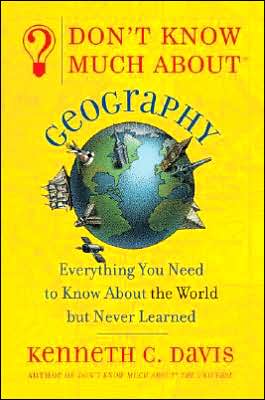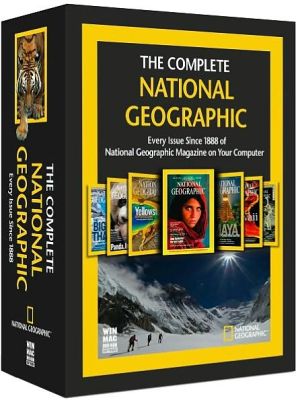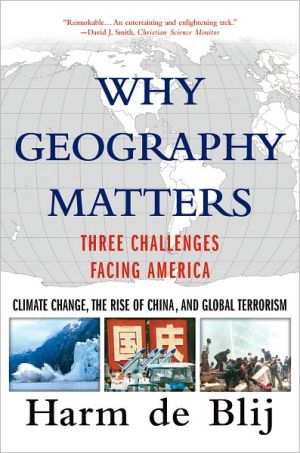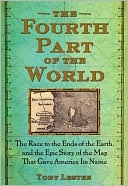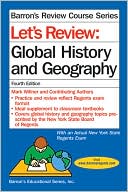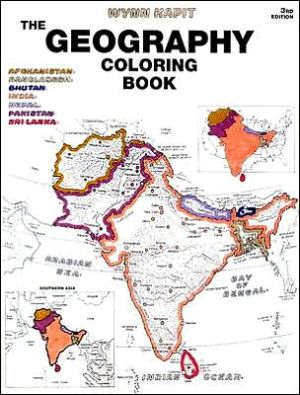Don't Know Much About Geography: Everything You Need to Know About the World But Never Learned
Who Killed The Dead Sea? Where was the Garden of Eden? What's So Bad About the Badlands?\ Get on board as Kenneth C. Davis, author of the acclaimed national bestseller Don't Know Much About® History, takes us on a fascinating, breathtaking, and hilarious grand tour of the planet Earth — opening our eyes and imaginations to a wide, wild, and wonderful world we never knew.\ \ \ Now in trade paperback to coincide with Geography Awareness Week in November, the latest...
Search in google:
From often amusing perceptions people have had through the ages about the world and the universe to the changing map of today, Davis shows how geography is really a great crossroads of many fields: biology, meteorology, astronomy, history, economics, and even politics. In this lively, entertaining, and endlessly fascinating presentation, you'll hear about the personalities that helped shape the world and learn the answers to questions that have vexed most of us since grade school. Along the way, Davis offers an affectionate ode to the earth: a celebration of the earth, a searching investigation of the destruction of our habitat, and a practical guide to saving our home planet.For anyone who has felt geographically ignorant ever since gas stations stopped handing out free maps, Don't Know Much About® Geography is enormously informative entertainment. Publishers Weekly The author of the successful Don't Know Much About History returns to correct his countrymen's lack of knowledge about geography, a lack established when Americans aged 18 to 24 scored lowest on a 1988 test of geographic literacy given to young people of all industrialized nations. Davis writes with an entertaining, breezy touch and encompasses such interesting considerations as the origin of the belief in a race of Amazons. Besides essential geographic information, chapters cover the history of geographical studies, an overview of large cities of the past and present, the effect of climate on developing civilizations and astronomy. Helpful lists, ranging from glossaries to current and former names of countries and U.N. membership are included. Davis's eminently readable treatise should help remedy an ignorance that has even been discussed in the U.S. Senate. Author tour. (Oct.)\\
Introduction\ How come the Nile River flows up?\ Way back in elementary school, I had a social-studies teacher I'll call Mrs. McNally. One day, in the midst of a geography lesson, Mrs. McNally lost it. Things started to fall apart for her when she pulled down one of those wonderful window-shade maps we had in grade school.\ Remember them? Three or four maps mounted over the black board? You pulled one down and it usually snapped right back up again. Geography class sometimes looked like a Three Stooges routine.\ On this particular morning, it was a map of Africa since the class was studying Egypt and the Nile River. As the teacher spoke, a small hand shot up and a tiny voice asked, "How come the Nile River flows up?"\ Today, it seems like a silly, yet innocent, child's question. (If you are asking yourself the same question, then you really need this book!) But back then, it was a puzzle that immediately caught the attention of the whole class. With the proverbial light bulb clicking on over our heads, we all wondered, "Yeah, how could a river flow up?"\ To our fifth-grade minds, it simply made no sense for a river to flow up the map. Everybody knew that water had to flow down. We had caught the teacher in a very obvious mistake.\ Of course, on a map oriented along the lies of this jingle:\ North to the ceiling,\ South to the floor,\ West to the window,\ East to the door\ it did appear that the Nile River flowed up.\ I can't tell you much else about what happened in that classroom that year. But I can report that this question prompted a small class room revolt.Try as she might, Mrs. McNally could not get across to this group of ten-year-olds that there was a difference between up and the compass direction north depicted on the map, and consequently that the Nile River actually flowed down from the mountains in East Africa to the Mediterranean Sea.\ I don't remember exactly how she tried to make this point, but I do recall that she failed--miserably. It was hopeless. Mrs. McNally grew so frustrated with our inability to grasp this elementary geographic concept that she blew her top. We ended up receiving some ghastly--and unjust--punishment, like no recess or a day's detention for the entire class.\ Through the years, that nightmarish geography lesson has stayed with me. I suppose it's a grim example of how grossly inadequate teachers can sometimes be. (Before the teachers' union comes after me with a noose, I'll add that I have had a great many wonderful teachers who gave me a love of learning and who made the class room a pleasure. They deserve much more credit than they get from educational critics.)\ But that lesson also leaves me wondering how many kids actually got things straight. I'm sure that Mrs. McNally wasn't the only one out there struggling to get across a point. Her failure as a geography teacher, it now seems obvious, was not an isolated case. If we are to believe the constant parade of statistical evidence issuing from the National Geographic Society and other keepers of the geographical flame, Americans constitute something of a "lost society."\ The most notorious recent example of Americans' collective in ability to know where they are and how to get from here to there came from a Gallup survey commissioned by the National Geographic Society on its hundredth anniversary in 1988. This survey, which gave people an unmarked map of the world and asked them to locate several selected countries, Central America, and two bodies of water, was designed to test adults in several industrialized nations. Among those surveyed, American adults came in sixth in geographic literacy, with only those from Italy and Mexico scoring lower than the Americans. The Swedes and West Germans won the gold and silver, with the Japanese taking the bronze in this geographic Olympics. Even more disheartening was the performance of Americans eighteen to twenty-four years old. They finished last among their peers.\ In a more comprehensive survey of America's "GQ" (Geographic Quotient), the results showed that as a nation we are quite lost when it comes to knowing where in the world we are. And these were not arcane, academic abstractions. The questions posed in this survey related to pressing issues of national interest, such as the whereabouts of the contra rebels that our government was then funding in a war against Nicaragua's government, or the location of the Persian Gulf, where American vessels were then patrolling to protect oil shipping lanes against the threat of Iranian attack. In another part of this survey, surprising numbers of people were unable to answer simple questions based upon looking at a map.\ What's wrong with our sense of direction? Maybe it is this simple: Americans became geographically stupid when gas stations stopped giving out free road maps.\ New York Times columnist Russell Baker once offered another explanation in response to that Geographic Society survey. The problem, according to Baker, stems from the availability of R-rated movies and Playboy magazine. Before kids could see naked women in these movies and magazines, Baker pointed out, they had to turn to "The National Geographic" to get their information. "In the course of the research," wrote Baker, "a good deal of other information rubbed off the page onto the student."\ For most people, more likely, it is probably a combination of disinterest and having encountered a Mrs. McNally somewhere along the road in their education. Judging from a sampling of geography textbooks, the materials we provide for learning might contribute to the problem as well. Take this nugget extracted from a current geography textbook:\ The internal uniformity of a homogeneous region can be expressed by human (cultural, economic) criteria. A country constitutes such a political region, for within its boundaries certain conditions of nationality, law, government and political traditions prevail.... Regions marked by this internal homogeneity are classified as formal regions.\ Regions conceptualized as spatial systems--such as those centered on an urban core, an activity node, or focus of regional interaction--are identified collectively as functional regions. Thus the formal region might be viewed as static, uniform and immobile; the functional region is seen to be dynamic, structurally active, and continuously shaped by forces that modify it.\ Whew! "Internal homogeneity"? "Activity nodes"? "Regional interaction"? If "dumbing down" textbooks will get rid of this kind of academic gibberish, I say bring on the dumb-downers.\ What is so sad about the failure to understand geography is that it reveals a complete misunderstanding of what geography is. In its simplest expression, geography asks humanity's oldest, most fundamental questions:\ "Where am I?"\ "How do I get there?"\ "What is on the other side of the mountain?"\ These primal questions have been responsible for pushing humanity from one place to another in search of something better. Eventually, these questions have pushed us off the face of the Earth and into the heavens in search of answers to even bigger questions:\ "Where do we come from?"\ "Is there anybody else out there?"\ "Who or what put this universe together?"\ Geography doesn't simply begin and end with maps showing the location of all the countries of the world. In fact, such maps don't necessarily tell us much. No--geography poses fascinating questions about who we are and how we got to be that way, and then provides clues to the answers. It is impossible to understand history, international politics, the world economy, religious, philosophy, or "patterns of culture" without taking geography into account.\ \\
Introduction13Ch. 1The World Is a Pear27Ch. 2What's So Bad About the Badlands?75Ch. 3If People Were Dolphins, the Planet Would be Called Ocean157Ch. 4Elephants in the Alps195Ch. 5Paradise Lost?: Geography, Weather, and the Environment269Ch. 6Lost in Space?309Appendix I: What the Hell Is a Hoosier?: Names and Nicknames of the 50 American States329Appendix II: Table of Comparative Measures341Appendix III: The Nations of the World349Bibliography355Index367\\
\ Publishers Weekly - Publisher's Weekly\ The author of the successful Don't Know Much About History returns to correct his countrymen's lack of knowledge about geography, a lack established when Americans aged 18 to 24 scored lowest on a 1988 test of geographic literacy given to young people of all industrialized nations. Davis writes with an entertaining, breezy touch and encompasses such interesting considerations as the origin of the belief in a race of Amazons. Besides essential geographic information, chapters cover the history of geographical studies, an overview of large cities of the past and present, the effect of climate on developing civilizations and astronomy. Helpful lists, ranging from glossaries to current and former names of countries and U.N. membership are included. Davis's eminently readable treatise should help remedy an ignorance that has even been discussed in the U.S. Senate. Author tour. (Oct.)\\\ \ \ \ \ Children's LiteratureThe amount of information contained in this book is amazing. The author begins at approximately 5000 B.C. and brings us up to the present day. The topic is geography but there is as much history provided as geography. In fact, the author states that geography is history. The early perceptions of the world, from being flat to curved, led to the production of maps that produced misleading information. The chronology of mapping is an early segment of the book. It is indicated that the oldest known map of a city, Lagash in Mesopotamia, was found carved in stone circa 2300 B.C. One of the author's humorous moments is when he criticizes Columbus for "discovering the new world" where forty-million people already lived. Later chapters examine the changes in the appearances of the world map based on historical and political changes that have occurred. War strategies are based on the geographic makeup of the battlefields. A perfect example of this is the 2001 war in Afghanistan. Because of the terrain, the strategies for fighting are much different that they would be in a desert environment. The author also points out that a country's growth and development is directly related to its geographic size. A perfect example is Japan. Because of its small size and limited resources, Japan has become self-sufficient and produces everything smaller, for example, smaller cars and miniaturized transistors. In the last stages of the book the author focuses on the environment, man's relationship with the environment and how man is jeopardizing the future life of our planet. When you finish this book you will know more about geography than you ever learned in any of your schooling. Part of the "Don't Know MuchAbout" series. 2001, Perennial, $14.00. Ages 16 up. Reviewer: Leila Toledo\\\ \ \ Library JournalAny efforts to save the U.S. public from geographic illiteracy should certainly be encouraged. Davis attempts to achieve this goal with a cheerful writing style, a varied format--e.g., cartoons, text, milestones in geography, and quotations from fascinating travel writings of previous centuries--and an environmentalist bent. The text, which could have been better organized, begins with a historical overview of geography, then moves to mountains, oceans, early human history, climate, and space, and closes with a bibliography (including a list of books for children) and an index (not seen). For general collections. Previewed in Prepub Alert, LJ 6/1/92.-- Mary L. Larsgaard, Univ. of California-Santa Barbara Map & Imagery Lab Lib.\\\ \ \ \ \ School Library JournalGr 7 Up-Kenneth C. Davis proves there is a lot more to geography then labeling countries on a map.\ \
